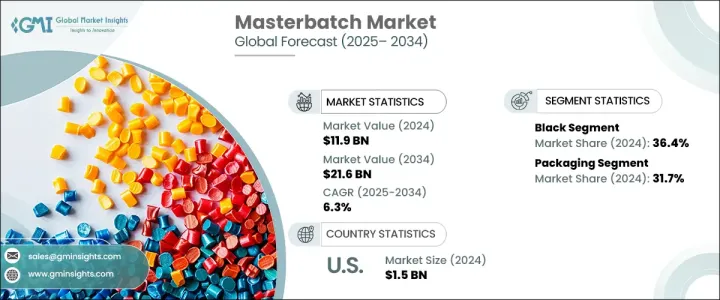
세계의 마스터배치 시장은 2024년에 119억 달러에 달했고, 2025년부터 2034년까지 연평균 복합 성장률(CAGR) 6.3%를 나타낼 것으로 예측됩니다.
특히 자동차, 포장, 건설 등 여러 산업에서 플라스틱의 사용이 증가하고 있다는 점이 이러한 성장을 뒷받침하고 있습니다. 자동차의 연비 향상과 배출 가스 삭감을 위해 경량 소재가 중시되어 자동차 제조업체가 선진적인 폴리머 솔루션을 요구하게 되어 있습니다. 또한 플라스틱은 금속에 비해 범용성이 높고, 설계의 유연성, 비용 대비 효과, 내부식성이 뛰어나기 때문에 널리 지지되고 있습니다.

심미적인 커스터마이즈에의 요구의 높아짐은 내자외선성, 항균성, 난연성 등의 기능적 특성과 더불어, 마스터배치를 현대의 플라스틱 제조에 불가결한 것으로 하고 있습니다. 급속한 도시화와 함께 지속 가능한 고품질 포장 솔루션에 대한 수요가 증가하면서 마스터배치 제형의 혁신이 더욱 가속화되고 있습니다.
| 시장 범위 | |
|---|---|
| 시작 연도 | 2024년 |
| 예측 연도 | 2025-2034년 |
| 시작 금액 | 119억 달러 |
| 예측 금액 | 216억 달러 |
| CAGR | 6.3% |
마스터배치 시장은 블랙, 화이트, 컬러, 첨가제 마스터배치로 구분되며, 각각 특정 산업 요구에 대응하고 있습니다. 제품에 있어서 매우 중요합니다. 기능성과 외형의 아름다움의 양쪽 모두가 중요시되는 자동차 부품, 농업용 필름, 건축 재료 등에 널리 사용되고 있습니다. 고성능 블랙 마스터배치 수요는 급증하고 있습니다. 또한, 블랙 마스터배치를 사용한 농업용 필름은 장기적인 현장에서의 용도에 불가결한 내구성과 내자외선성이 강화되고 있습니다.
최종 사용자 산업을 기반으로 마스터배치 시장에는 농업, 자동차, 포장, 건설, 소비재 등이 포함되어 있습니다. 플라스틱 포장의 외관과 성능을 모두 향상시키는 데 도움이 되어 선명한 색채, 내자외선성에 의한 보존 기간의 연장, 내구성의 강화 등의 장점을 제공합니다.
2024년 미국의 마스터배치 시장 규모는 15억 달러로 자동차와 건설 등 주요 산업의 견조한 성장에 지지되었습니다. 건설 부문은 또한 색상의 일관성과 재료 강도가 중요한 지붕, 배관, 안전 바리케이드 등의 용도로 마스터배치 수요를 이끌고 있습니다.
The Global Masterbatch Market reached USD 11.9 billion in 2024 and is projected to grow at a CAGR of 6.3% between 2025 and 2034. The rising use of plastics across multiple industries, especially automotive, packaging, and construction, is fueling this growth. As manufacturers continue to replace traditional metal components with high-performance plastics, the demand for masterbatches that enhance the appearance, durability, and functionality of plastic products is rising sharply. Increasing emphasis on lightweight materials to improve fuel efficiency and reduce emissions in vehicles is pushing automotive manufacturers toward advanced polymer solutions. In addition, plastics are widely favored for their versatility, design flexibility, cost-effectiveness, and resistance to corrosion compared to metals.

The growing need for aesthetic customization, coupled with functional properties such as UV resistance, antimicrobial protection, and flame retardancy, makes masterbatches an essential part of modern plastic manufacturing. Industries such as consumer goods, electronics, agriculture, and healthcare are also leveraging masterbatches to meet evolving product design and regulatory standards. Rapid urbanization, along with rising demand for sustainable and high-quality packaging solutions, further drives innovation in masterbatch formulations. With increasing regulatory focus on sustainability, manufacturers are also developing eco-friendly and biodegradable masterbatch solutions to meet global environmental goals, opening new avenues for market expansion.
| Market Scope | |
|---|---|
| Start Year | 2024 |
| Forecast Year | 2025-2034 |
| Start Value | $11.9 Billion |
| Forecast Value | $21.6 Billion |
| CAGR | 6.3% |
The masterbatch market is segmented into black, white, color, and additive masterbatches, each serving specific industrial needs. Among these, black masterbatch held a dominant market share of 36.4% in 2024. Known for its high carbon black content, black masterbatch delivers superior UV protection, thermal stability, and mechanical strength, making it crucial for products exposed to extreme environmental conditions. It is widely used in automotive components, agricultural films, and construction materials where both functionality and visual appeal are important. As automakers focus on lightweight and fuel-efficient designs, the demand for high-performance black masterbatch continues to surge. Additionally, agricultural films made with black masterbatch offer enhanced durability and UV resistance, which are vital for long-term field applications.
Based on end-user industries, the masterbatch market includes agriculture, automotive, packaging, construction, consumer goods, and others. The packaging segment led the market with a 31.7% share in 2024, driven by increasing demand for innovative and visually attractive packaging solutions. Masterbatches help improve both the appearance and performance of plastic packaging, offering benefits such as vibrant colors, extended shelf-life through UV resistance, and enhanced durability. In a competitive consumer market, brands are using high-quality masterbatch solutions to ensure their packaging stands out on the shelf and maintains product integrity.
U.S. masterbatch market was valued at USD 1.5 billion in 2024, supported by robust growth in key industries such as automotive and construction. Automakers across the country rely on masterbatches to improve the appearance, strength, and performance of interior and exterior car parts. The construction sector is also driving demand for masterbatches in applications like roofing, plumbing, and safety barricades, where color consistency and material strength are crucial. With a strong manufacturing base and increasing focus on advanced materials, the U.S. remains one of the leading markets for masterbatch solutions globally.